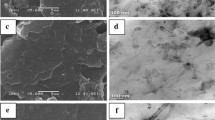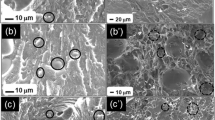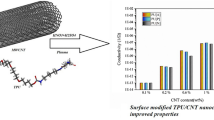Abstract
This work aims to investigate how adding functionalized carbon nanotubes (CNTs) to a Polyamide 6/polypropylene blend influences its properties. CNT functionalization was carried on through plasma with oxygen (CNT_O2) or maleic anhydride (CNT_MA). CNT_O2 presented the highest amount of oxygen, but, as the treatment time in plasma was twice as long as that of the CNT_MA sample, the oxygenated groups, for the most part, tended to formed lactones. On the other hand, plasma treatment with maleic anhydride was more efficient to insert carboxylic groups onto the CNT surface. Adding non-functionalized CNT in the blend, an elongation of PP phase was observed. In the functionalized CNT nanocomposites, a significant decrease in phase size was observed. No improvement in adhesion between phases was observed. Crystallinity degree decreased when non-functionalized CNT was added and increased with functionalized CNT. Despite the greater interaction between amorphous and crystalline regions observed in nanocomposites with CNT_O2, the highest values of storage module came from CNT_MA nanocomposite. The COOH groups on the CNT surface reacted with the polyamide, improving tension transfer between phases and leading to a better performance in blend mechanical properties.







Similar content being viewed by others
References
Chow WS, Ishiaku US, Ishak ZAM et al (2003) Polyamide/Polypropylene/Organoclay nanocomposites: influence of organoclay and compatibiliser on the morphological and tensile properties. J Teknol 39:45–54. https://doi.org/10.11113/jt.v39.440
Tang Y, Hu Y, Zhang R et al (2004) Investigation on polypropylene and polyamide-6 alloys/montmorillonite nanocomposites. Polymer 45:5317–5326. https://doi.org/10.1016/j.polymer.2004.03.090
Afshari M, Kotek R, Kish MH et al (2002) Effect of blend ratio on bulk properties and matrix-fibril morphology of polypropylene/nylon-6 polyblend fibers. Polymer 43:1331–1341. https://doi.org/10.1016/S0032-3861(01)00689-9
La Mantia FP, Capizzi L (2001) Recycling of compatibilized and uncompatibilized nylon/polypropylene blends. Polym Degrad Stab 71:285–291. https://doi.org/10.1016/S0141-3910(00)00177-4
Agrawal P, Rodrigues AWB, Araújo EM et al (2010) Influence of reactive compatibilizers on the rheometrical and mechanical properties of PA6/LDPE and PA6/HDPE blends. J Mater Sci 45:496–502. https://doi.org/10.1007/s10853-009-3967-9
Misra A, Sawhney G, Kumar RA (1993) Structure and properties of compatibilized blends of polyamide-6 and ABS. J Appl Polym Sci 50:1179–1186. https://doi.org/10.1002/app.1993.070500708
Becker D, Hage E Jr, Pessan LA (2007) Synthesis and characterization of poly(methyl methacrylate-co-maleic anhydride) copolymers and its potential as a compatibilizer for amorphous polyamide blends. J Appl Polym Sci 106:3248–3252. https://doi.org/10.1002/app.26836
Taguet A, Cassagnau P, Lopez-Cuesta J-M (2014) Structuration, selective dispersion and compatibilizing effect of (nano) fillers in polymeric blends. Prog Polym Sci 39:1526–1563. https://doi.org/10.1016/j.progpolymsci.2014.04.002
Mofokeng JP, Luyt AS (2015) Morphology and thermal degradation studies of melt-mixed poly (lactic acid) (PLA)/poly(ε-caprolactone) (PCL) biodegradable polymer blend nanocomposites with TiO2 as filler. Polym Test 45:93–100. https://doi.org/10.1016/j.polymertesting.2015.05.007
Wu D, Lin D, Zhang J et al (2011) Selective localization of nanofillers: effect on morphology and crystallization of PLA/PCL Blends. Macromol Chem Phys 212:613–626. https://doi.org/10.1002/macp.201000579
Baudouin A-C, Bailly C, Devaux J (2010) Interface localization of carbon nanotubes in blends of two copolymers. Polym Degrad Stab 95:389–398. https://doi.org/10.1016/j.polymdegradstab.2009.11.007
Cayla A, Campagne C, Rochery M et al (2011) Electrical, rheological properties and morphologies of biphasic blends filled with carbon nanotubes in one of the two phases. Synth Met 161:1034–1042. https://doi.org/10.1016/j.synthmet.2011.03.012
Göldel A, Marmur A, Kasaliwal GR et al (2011) Shape-dependent localization of carbon nanotubes and carbon black in an immiscible polymer blend during melt mixing. Macromolecules 44:6094–6102. https://doi.org/10.1021/ma200793a
Muhulet A, Miculescu F, Voicu SI et al (2018) Fundamentals and scopes of doped carbon nanotubes towards energy and biosensing applications. Mater Today Energy 9:154–186. https://doi.org/10.1016/j.mtener.2018.05.002
Kim SW, Kim T, Kim YS et al (2012) Surface modifications for the effective dispersion of carbon nanotubes in solvents and polymers. Carbon 50:3–33. https://doi.org/10.1016/j.carbon.2011.08.011
Madhukar K, Sainath AVS, Rao BS et al (2012) Role of carboxylic acid functionalized single walled carbon nanotubes in polyamide 6/poly(methyl methacrylate) blend. Polym Eng Sci. https://doi.org/10.1002/pen.23272
Cheng HKF, Sahoo NG, Khin TH et al (2010) The role of functionalized carbon nanotubes in a PA6/LCP blend. J Nanosci Nanotechnol 10:5242–5251. https://doi.org/10.1166/jnn.2010.2415
Zhang L, Wan C, Zhang Y (2009) Investigation on the multiwalled carbon nanotubes reinforced polyamide 6/polypropylene composites. Polym Eng Sci 49:1909–1917. https://doi.org/10.1002/pen.21428
Wang L, Guo Z-X, Yu J (2014) Effects of carbon nanotubes on the morphology and properties of uncompatibilized and maleic anhydride-grafted polypropylene-compatibilized polyamide 6/polypropylene blends. J Macromol Sci Part B 53:1205–1221. https://doi.org/10.1080/00222348.2014.891170
Anjali S, Aishwaryalakshmi S, Ashwin V et al (2018) Effect of compatibilizer and carbon nanotubes on blends of polypropylene and nylon 6. Mater Today Proc 5:25524–25533. https://doi.org/10.1016/j.matpr.2018.10.359
Wu H-L, Wang C-H, Ma C-CM et al (2007) Preparations and properties of maleic acid and maleic anhydride functionalized multiwall carbon nanotube/poly(urea urethane) nanocomposites. Compos Sci Technol 67:1854–1860. https://doi.org/10.1016/j.compscitech.2006.10.028
Araújo RF, Proença MF, Silva CJ et al (2014) The solvent effect on the sidewall functionalization of multi-walled carbon nanotubes with maleic anhydride. Carbon 78:401–414. https://doi.org/10.1016/j.carbon.2014.07.019
Le CMQ, Cao XT, Lim KT (2017) Ultrasound-promoted direct functionalization of multi-walled carbon nanotubes in water via Diels-Alder “click chemistry”. Ultrason Sonochem 39:321–329. https://doi.org/10.1016/j.ultsonch.2017.04.042
Yao H, Zhou G, Wang W et al (2018) Effect of polymer-grafted carbon nanofibers and nanotubes on the interlaminar shear strength and flexural strength of carbon fiber/epoxy multiscale composites. Compos Struct 195:288–296. https://doi.org/10.1016/j.compstruct.2018.04.082
Tseng C-H, Wang C-C, Chen C-Y (2007) Functionalizing carbon nanotubes by plasma modification for the preparation of covalent-integrated epoxy composites. Chem Mater 19:308–315. https://doi.org/10.1021/cm062277p
Lu Y-Y, Li H, Liu H-Z (2010) Maleic anhydride functionalization of multi-walled carbon nanotubes by the electron beam irradiation in the liquid media. Phys E Low Dimens Syst Nanostruct 43:510–514. https://doi.org/10.1016/j.physe.2010.09.004
Steffen TT, Fontana LC, Hammer P et al (2019) Carbon nanotube plasma functionalization: the role of carbon nanotube/maleic anhydride solid premix. Appl Surf Sci 491:405–410. https://doi.org/10.1016/j.apsusc.2019.06.176
Huang YL, Ma C-CM, Yuen S-M et al (2011) Effect of maleic anhydride modified MWCNTs on the morphology and dynamic mechanical properties of its PMMA composites. Mater Chem Phys 129:1214–1220. https://doi.org/10.1016/j.matchemphys.2011.06.020
Steffen TT, Fontana LC, Nahorny J et al (2019) Role of nitrogen–oxygen plasma functionalization of carbon nanotubes in epoxy nanocomposites. Polym Compos 40:E1162–E1171. https://doi.org/10.1002/pc.24921
Loos MR, Nahorny J, Fontana LC (2013) Plasma modification of carbon nanotubes. Curr Org Chem 17:1880–1893. https://doi.org/10.2174/13852728113179990089
Karger-Kocsis J (1995) Polypropylene structure, blends and composites England 1995, vol 1. Champman and Hall England, London
Wang H, Huang R, Wu D et al (2013) Effects of thermal oxygen aging on the crystallization behavior and properties of nylon 6. Polym Mater Sci Eng 29:88–92
Lee S, Liu YC, Chen CH (2012) Raman study of the temperature-dependence of plasma induced defect formation rates in carbon nanotubes. Carbon 50:5210–5216. https://doi.org/10.1016/j.carbon.2012.07.004
Mercier G, Gleize J, Ghanbaja J et al (2013) Soft oxidation of single-walled carbon nanotube samples. J Phys Chem C 117:8522–8529. https://doi.org/10.1021/jp400890n
Talla J, Zhang D, Kandadai M et al (2010) A resonance Raman study of carboxyl induced defects in single-walled carbon nanotubes. Phys B 405:4570–4573. https://doi.org/10.1016/j.physb.2010.08.041
Hoa LETM (2018) Characterization of multi-walled carbon nanotubes functionalized by a mixture of HNO3/H2SO4. Diam Relat Mater 89:43–51. https://doi.org/10.1016/j.diamond.2018.08.008
Harb SV, Pulcinelli SH, Santilli CV et al (2016) A comparative study on graphene oxide and carbon nanotube reinforcement of PMMA-siloxane-silica anticorrosive coatings. Appl Mater Inter 8:16339–16350. https://doi.org/10.1021/acsami.6b04780
Chiang CL, Wang CC, Chen CY (2018) Carbon nanotubes functionalized with maleic anhydride chelated silver nanoparticles as conductive additives for polyanion-based lithium-ion batteries. Mater Sci Eng B 238–239:42–49. https://doi.org/10.1016/j.mseb.2018.12.013
Mishra G, McArthur SL (2010) Plasma polymerization of maleic anhydride: just what are the right deposition conditions? Langmuir 26:9645–9658. https://doi.org/10.1021/la100236c
Ma J, Wang W, Huang J et al (2009) Surface structure and hydrophilicity of polypropylene porous membranes modified by maleic anhydride plasma polymerization. Polym Mater Sci Eng 25:16–18
Chen C, Liang B, Ogino A et al (2009) Oxygen functionalization of multiwall carbon nanotubes by microwave-excited surface-wave plasma treatment. J Phys Chem C 113:7659–7665. https://doi.org/10.1021/jp9012015
Saka C (2018) Overview on the surface functionalization mechanism and determination of surface functional groups of plasma treated carbon nanotubes. Crit Rev Anal Chem 2:1–14. https://doi.org/10.1080/10408347.2017.1356699
Huber T, Misra M, Mohanty AK (2014) Mechanical properties of compatibilized nylon 6/polypropylene blends; studies of the interfacial behavior through an emulsion model. J Appl Polym Sci. https://doi.org/10.1002/app.40792
Shin BY, Ha MH, Han DH (2016) Morphological, rheological, and mechanical properties of polyamide 6/polypropylene blends compatibilized by electron-beam irradiation in the presence of a reactive agent. Materials. https://doi.org/10.3390/ma9050342
Moud AA, Javadi A, Nazockdast H et al (2014) Effect of dispersion and selective localization of carbon nanotubes on rheology and electrical conductivity of polyamide 6 (PA 6), Polypropylene (PP), and PA 6/PP nanocomposites. J Polym Sci Polym Phys 53:368–378. https://doi.org/10.1002/polb.23638
Zeng H, Gao C, Wang Y et al (2006) In situ polymerization approach to multiwalled carbon nanotube-reinforced nylon 1010 composites: mechanical properties and crystallization behavior. Polymer 47:113–122. https://doi.org/10.1016/j.polymer.2005.11.009
Scaffaro R, Maio A, Agnello S et al (2012) Plasma Functionalization of Multiwalled Carbon Nanotubes and Their Use in the Preparation of Nylon 6-Based Nanohybrids. Plasma Process Polym 9:503–512. https://doi.org/10.1002/ppap.201100140
Liu H, Wang X, Fang P et al (2010) Functionalization of multi-walled carbon nanotubes grafted with self-generated functional groups and their polyamide 6 composites. Carbon 48:721–729. https://doi.org/10.1016/j.carbon.2009.10.018
Ying LY, Zhuang XJ, Yang LX et al (2013) Role of surface chemical groups on carbon nanotubes in nucleation for polymer crystallization: Interfacial interaction and steric effect. Polymer 54:6479–6488. https://doi.org/10.1016/j.polymer.2013.09.027
Bikiaris D, Vassiliou A, Chrissafis K et al (2008) Effect of acid treated multi-walled carbon nanotubes on the mechanical, permeability, thermal properties and thermo-oxidative stability of isotactic polypropylene. Polym Degrad Stab 93:952–967. https://doi.org/10.1016/j.polymdegradstab.2008.01.033
Stankowski M, Kropidowska A, Gazda M et al (2008) Properties of polyamide 6 and thermoplastic polyurethane blends containing modified montmorillonites. J Therm Anal Calorim 94:817–823. https://doi.org/10.1007/s10973-007-8886-x
Zwane RDS, Sadiku ER, Ray SS et al (2019) Thermal and rheological properties of polyamide 6/layered double hydroxide clay composites. Polym Polym Compos 27:567–581. https://doi.org/10.1177/0967391119853969
Rotter G, Ishida H (1992) Dynamic mechanical analysis of the glass transition: curve resolving applied to polymers. Macromolecules 25:2170–2176. https://doi.org/10.1021/ma00034a017
Kondratowicz I et al (2018) Tailoring properties of reduced graphene oxide by oxygen plasma treatment. Appl Surf Sci 440:651–659. https://doi.org/10.1016/j.apsusc.2018.01.168
Filippi S, Chiono V, Polacco G et al (2002) Reactive compatibilizer precursors for LDPE/PA6 blends, 1 Ethylene/acrylic acid copolymers. Macromol Chem Phys 203:1512–1525. https://doi.org/10.1002/1521-3935(200207)203:10/11<1512:AID-MACP1512>3.0.CO;2-G
La Mantia FP, Ceraulo M, Mistretta MC et al (2019) Compatibilization of Polypropylene/Polyamide 6 Blend Fibers Using Photo-Oxidized Polypropylene. Materials. https://doi.org/10.3390/ma12010081
Acknowledgements
This study was partly financed by the Coordenação de Aperfeiçoamento de Pessoal de Nível Superior—Brasil (CAPES)—Finance Code 001. The authors would like to thank Conselho Nacional de Desenvolvimento Científico e Tecnológico (CNPq) and Fundação de Amparo à Pesquisa e Inovação do Estado de Santa Catarina/Programa de Apoio à Pesquisa (FAPESC/PAP) for the financial resources.
Author information
Authors and Affiliations
Corresponding author
Ethics declarations
Conflicts of interest
No conflict of interest exists.
Additional information
Publisher's Note
Springer Nature remains neutral with regard to jurisdictional claims in published maps and institutional affiliations.
Rights and permissions
About this article
Cite this article
Rocha, J.A., Steffen, T.T., Fontana, L.C. et al. Effect of maleic anhydride and oxygen functionalized carbon nanotube on polyamide 6 and polypropylene blend properties. Polym. Bull. 78, 5623–5639 (2021). https://doi.org/10.1007/s00289-020-03394-y
Received:
Revised:
Accepted:
Published:
Issue Date:
DOI: https://doi.org/10.1007/s00289-020-03394-y




